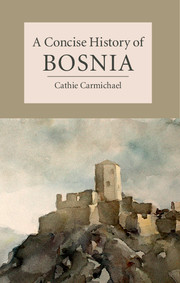Book contents
- Frontmatter
- Contents
- List of figures
- List of maps
- Acknowledgements
- Preface
- Chronology of events in Bosnian history
- 1 Introduction
- 2 Bosnia, Hercegovina and the Ottoman Empire (1463–1912)
- 3 Rebellion, war and the Habsburgs (1875–1918)
- 4 Royalist Yugoslavia, the Independent State of Croatia and the Second World War (1918–1945)
- 5 Bosnia and the Communist experiment
- 6 Bosnian independence, war and genocide
- 7 Conclusion: ‘unmixing’ Bosnia and Hercegovina
- Bibliography
- Index
7 - Conclusion: ‘unmixing’ Bosnia and Hercegovina
Published online by Cambridge University Press: 05 July 2015
- Frontmatter
- Contents
- List of figures
- List of maps
- Acknowledgements
- Preface
- Chronology of events in Bosnian history
- 1 Introduction
- 2 Bosnia, Hercegovina and the Ottoman Empire (1463–1912)
- 3 Rebellion, war and the Habsburgs (1875–1918)
- 4 Royalist Yugoslavia, the Independent State of Croatia and the Second World War (1918–1945)
- 5 Bosnia and the Communist experiment
- 6 Bosnian independence, war and genocide
- 7 Conclusion: ‘unmixing’ Bosnia and Hercegovina
- Bibliography
- Index
Summary
THE IMPACT OF WAR
Exactly 50 years after the apogee of the Independent State of Croatia, the Bosnian Serb Republic created by Radovan Karadžić and Ratko Mladić was at the peak of its territorial extent. The Serbs had pushed through Bosnia expelling, raping and murdering the local populations. By 1993, they controlled approximately 70 per cent of Bosnia and Hercegovina. As a consequence, Mladić was reluctant to sign the Vance–Owen Plan precisely because for him this would have represented territorial rollback. The year 1993 probably represented the peak phase of Serbian nationalism and expansion. In 1995, the Bosnian Serbs agreed to the partition of the state and reluctantly accepted the loss of Sarajevo and its environs as the tide of the war had turned against them. To create greater Serbian or greater Croatian states, both the Ustaša and Bosnian Serbs had committed or attempted to commit genocide. For a historian, the common denominator linking the 1940s to the 1990s is not simply the readiness of some political agents to commit war crimes including mass murder, but also the inherent instability of Bosnia as a state. The root cause of violence was the Serbs' discontent with borders of the successor states. Serbs revived old fascist plans for ethnic cleansing from the Second World War during which Bosnian Muslims had been attacked by Serb nationalists. Undoubtedly distrust of Muslims existed at the level of Serb popular culture as well as a hatred of the Ustaša and Croatian nationalism, but this itself was not the primary cause of the fighting. The war was one of intricate strategy to gain as much territory and people for any future Serbian state(s) as possible and frequently coordinated by nationalists from within Serbia itself. This strategy failed in Kosovo, Krajina and Croatia but worked in Bosnia, where violence was ‘rewarded’ by the Dayton Treaty.
- Type
- Chapter
- Information
- A Concise History of Bosnia , pp. 171 - 190Publisher: Cambridge University PressPrint publication year: 2015

